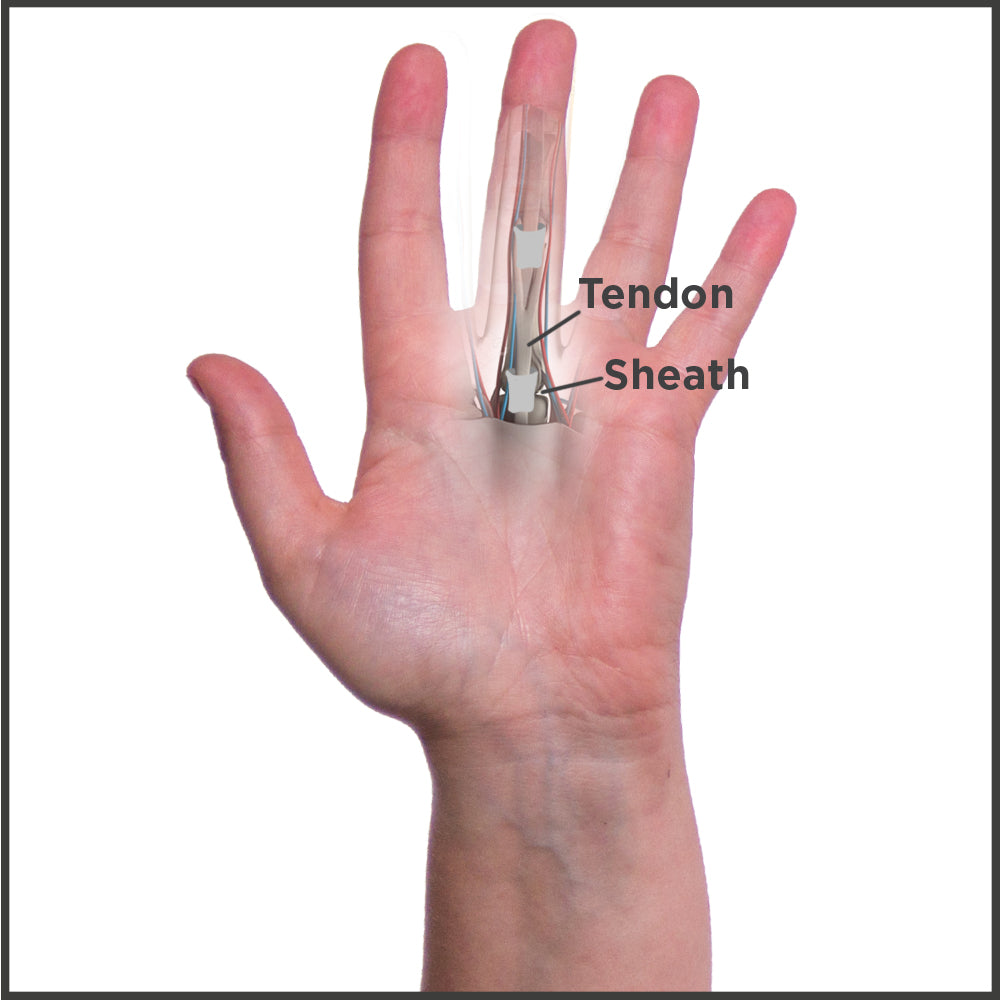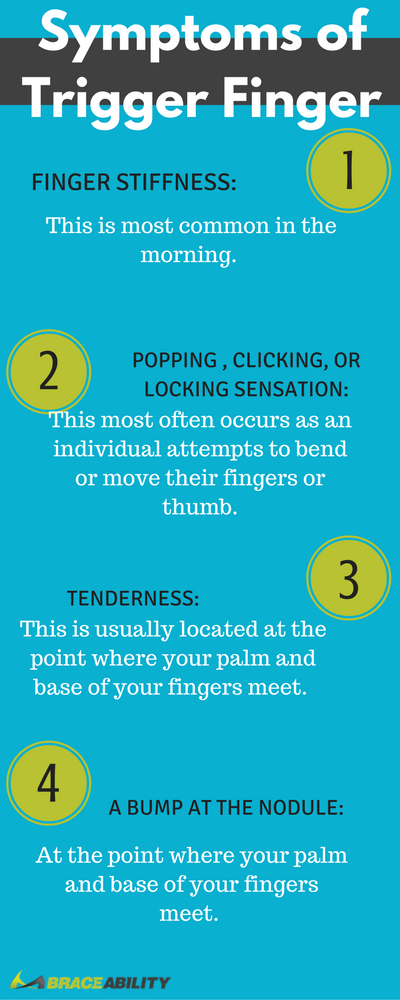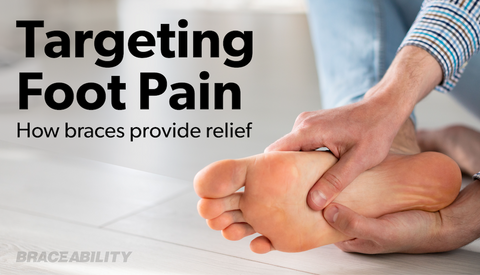Trigger Finger
What is Trigger Finger?
As explained in the video above, trigger finger is a very common and painful problem. If you have trigger finger the tendons in your fingers are inflamed. Because these tendons are covered by a structure of tissues called a sheath, they will not glide properly if swollen. This means that your finger may lock, bend, knot, or snap. Trigger finger can occur in ANY of your fingers, including your thumb, index, middle, ring, and pinky.
What is the Anatomy of My Fingers?

The bones in your fingers are known as phalanges and you have 14 in each hand. Each of your fingers have 3 phalanges, however, your thumb only has 2. The muscles that allow for movement in our fingers are located in the forearm. We have long tendons that attach these muscles in our forearm to the bones of our fingers. These tendons are covered in a tunnel-like structure of tissues, called a sheath. When you bend your fingers the tendons slide through the sheaths to keep them in place next to your bones. If you suffer from trigger finger the sliding of the tendons through the sheath is interrupted by inflammation of the tendons.
What is Stenosing Tenosynovitis (Stuh-NO-sing-ten-o-sin-o-VIE-tis)?
You may have heard your doctor or a friend refer to your finger issues as stenosing tenosynovitis. To be clear, stenosing tenosynovitis and trigger finger are the exact same condition. Stenosing Tenosynovitis is the true medical term for trigger finger. The word tenosynovitis means inflammation or swelling of the sheath surrounding the tendon. This is most common in the wrist and hand areas. The word 'stenosing' implies the abnormal narrowing in a blood vessel or some kind of organ structure.
What Causes Trigger Finger Syndrome?
There is no clear and definitive cause of trigger finger. However, there are some clear circumstances that make trigger finger more common or at least increase your chances of getting trigger finger. These include the following:
-
The “Triad” of Conditions
Often times different medical conditions are seen all together on the same patient. When it comes to trigger finger, it often is seen alongside Dupuytren's contracture and carpal tunnel syndrome. Dupuytren Contracture is caused by the thickening of tissues in your palm, causing your fingers to unnaturally flex. Carpal tunnel is generally numbness, tingling, or weakness in your hand because of pressure on the median nerve in your wrist. All of these conditions are even more common in those with diabetes.
-
People with Diabetes
Research has shown an increased chance of the development of trigger finger in people who have diabetes. In general, people with diabetes tend to have joint issues that are usually related to the stiffening or thickening of connective tissues. Some people believe the high glucose levels of a diabetic may stiffen the collagen in their bodies. Obese individuals are more likely to develop diabetes, therefore, making them more susceptible to issues with trigger finger.
-
People with Rheumatoid Arthritis
Rheumatoid arthritis is a chronic disease that causes inflammation in the joints. This can occur throughout your body including your fingers, wrists, ankles, and feet. There is a clear connection between rheumatoid arthritis and trigger finger as your chances increase greatly if you are susceptible to inflammation. If you have issues with arthritis in your fingers read here to look at different thumb and finger brace options.
-
Occupations with Repeated Gripping
If you have a job that involves repeated and prolonged gripping your chances of trigger finger will increase. Examples of this include farmers, musicians, and industrial workers.
It’s also important to note that there is roughly a 4:1 ratio of women to men who have trigger finger. It becomes the most common in women ages 40 to 60 years old, although the reason for this is unknown. We will likely begin to see more and more cases of trigger thumb because of the increasing use of our fingers for technological devices, like texting on our mobile phones.
What are Symptoms of Stenosing Tenosynovitis or Trigger Finger?
Now that we’ve discussed what the actual condition is you are probably aware if it aligns with the problems you’ve been having. However, trigger finger does vary in its symptoms and may progress from mild to severe over time. Because of this is it not always clear if you do have trigger finger. Here is a list of additional trigger finger symptoms that may occur:
- Finger stiffness - this is most common in the morning
- A popping or clicking sensation as you attempt to move or bend your fingers
- Tenderness at the point where your palm and base of the finger meet
- A bump or nodule at the point where your palm and the base of your finger meet
- Fingers locked in a bent position for extended periods of time in which you are unable to straighten or move back into its correct position

Trigger Finger Test and Diagnosis to Fix Trigger Finger
There is no major diagnostic process of trigger finger. When you arrive at your doctor’s or health care providers they will perform a quick exam of your hand. The doctor will ask you to open and close your hand, looking for areas of pain. They will also be looking for how smooth the gliding movement of your hand is and if your fingers lock. Often times your doctors will check your palm for any type of lumps that may present, as this is a symptom of trigger finger.
What Finger Does Trigger Finger Most Commonly Affect?
Trigger finger is most commonly seen in your thumb (often called trigger thumb), your middle finger, and your ring finger. However, it happens in any and all of your finger. It’s possible that you are experiencing trigger finger in more than one of your fingers at a time. The condition is more common with the right hand, this is most likely because being right-handed is more common.
Is There A Natural Cure or Remedy for Trigger Finger/Thumb?
Thankfully, trigger finger is treatable and has a wide variety of different natural treatment options, some more conservative than others. To begin with, the more conservative at home healing remedies the main options are splinting, exercise, acupuncture, physical therapy, anti-inflammatory medicine, rest, icing, and heating.
-
Trigger Finger Splinting
Wearing a brace made specifically for trigger finger is a great way to alleviate and heal pain right away. Most people recommend wearing the brace at night to avoid any issues during the day. In order to have the most support, you’ll want a brace with a rigid finger splint. Splinting post surgery is often highly recommend to keep your finger isolated and protected.
-
Trigger Finger Exercise
Gentle exercises to help maintain mobility in your fingers will go a long way with trigger finger. Check out this blog post to get a few ideas for the best trigger finger exercises.
-
Trigger Finger Acupuncture
A number of acupuncture points can be found on the hand, which are often used to heal trigger finger pain. These points are called the baxie point and the jing well. There are different spots on the sides of the fingers that are also often used for acupuncture treatment.
-
Trigger Finger Physical Therapy
Because the issue with trigger finger is limited mobility of the finger, using physical trigger finger therapy exercises is a great way to work it out. A physical therapist will use a variety of trigger finger exercises to help stretch and work out your fingers. Often times strengthening exercises are also used to help control the movement of the hand. Highly recommended is a transverse friction massage that helps to break down the sheath.
These conservative and natural treatment options are great for mild cases of trigger finger, or people who have recently discovered their trigger finger. If you are finding no relief in conservative remedies consulting with your doctor may be the next best option.
Is There Surgery To Fix Trigger Finger?
In an estimated 85% of cases, trigger finger can be treated without surgery. However, sometimes if the pain is so debilitating and not disappearing surgery may be your best option. Before most doctors perform surgery on your finger they will try a surgical steroid injection. This steroid injection has strong proven results and is one of the most common treatment methods. There are two main types of trigger finger or thumb release surgeries. Both of these procedures involve the doctor “releasing,” or splinting the A1 pulley through which the tendon is having trouble passing. The difference between the two surgeries is how your doctor goes about performing them. If you want more information on surgical options, consult with your doctor. The surgeries performed yield as high as 100% success rates. Read more details on the surgical options for trigger finger.

Is There A Way to Prevent Trigger Finger?
Avoiding overuse is the main component of preventing trigger finger. If you have diabetes, rheumatoid arthritis, or any reason to believe you are more prone to getting trigger finger consider practicing the exercises from above. If you feel a slight onset of trigger finger resting your hand will be the most effective way to avoid further issues.
Does Trigger Finger or Thumb Occur in Children?
Yes, trigger finger can occur in children. In fact, trigger finger or thumb in children is referred to as congenital trigger thumb. Just as in adults, the same clicking, popping, or locking in the bent position occurs. There is some evidence that children with trigger finger may have been naturally born with the tendon irritation. While other people dispute the theory that trigger finger can be present at birth. Thus, the term “pediatric trigger thumb” is also used. Check out our blog to read more on trigger finger and thumb in kids.










